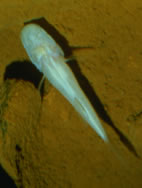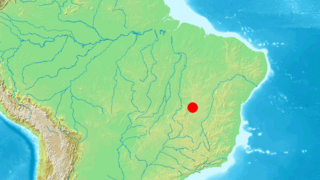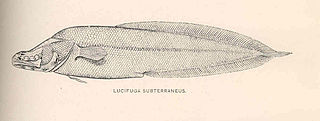 W
WCavefish or cave fish is a generic term for fresh and brackish water fish adapted to life in caves and other underground habitats. Related terms are subterranean fish, troglomorphic fish, troglobitic fish, stygobitic fish, phreatic fish and hypogean fish.
 W
WThe Alabama cavefish is a critically endangered species of amblyopsid cavefish found only in underground pools in Key Cave, located in northwestern Alabama, United States in the Key Cave National Wildlife Refuge. It was discovered underneath a colony of gray bats in 1967 by researchers Robert A. Kuehne and John E. Cooper and scientifically described in 1974.
 W
WThe Amblyopsidae are a fish family commonly referred to as cavefish, blindfish, or swampfish. They are small freshwater fish found in the dark environments of caves, springs and swamps in the eastern half of the United States. Like other troglobites, most amblyopsids exhibit adaptations to these dark environments, including the lack of functional eyes and the absence of pigmentation. More than 200 species of cavefishes are known, but only six of these are in the family Amblyopsidae. One of these, Forbesichthys agassizii, spends time both underground and aboveground. A seventh species in this family, Chologaster cornuta, is not a cave-dweller but lives in aboveground swamps.
 W
WAmblyopsis is a genus of small fish in the family Amblyopsidae that are endemic to the central and eastern United States. Like other cavefish, they lack pigmentation and are blind. The most recently described species was in 2014. Uniquely among fish, Amblyopsis brood their eggs in the gill chambers. It was formerly incorrectly speculated that the same brooding behavior existed in other genera in the family and in the pirate perch.
 W
WAstyanax jordani is a freshwater fish of the characin family of order Characiformes, native to Mexico. It is sometimes called the cave tetra, or by its local Spanish name tetra ciego.
 W
WThe blind cave eel is a species of fish in the family Synbranchidae. It is endemic to subterranean waters in the Pilbara region, Western Australia. Like other cavefish such as Milyeringa, the blind cave eel is entirely blind and lacks pigmentation. It is listed as vulnerable under the Australian Environment Protection and Biodiversity Conservation Act 1999. Reaching a length of 40 cm (16 in), it is the longest known cavefish.
 W
WEigenmannia vicentespelaea is a species of weakly electric knifefish in the family Sternopygidae. Native to the São Domingos karst area in central Brazil, it is the only known knifefish to exclusively inhabit caves. Measuring up to 12 cm (4.7 in) long, E. vicentespelaea can be distinguished from its relatives by its translucent body and reduced or absent eyes. As some individuals retain well-developed eyes, this fish may have colonized caves only recently in evolutionary time.
 W
WGarra barreimiae, the Oman garra, is a species of ray-finned fish in the family Cyprinidae. It is found in the mountains of northern Oman and in the United Arab Emirates. Most populations inhabit wadis, streams, pools and springs, but one population which lives in a cave system, is known as Omani blind cave fish, and has lost its sight and pigmentation. The only other cave fish in the Arabian Peninsula is the Tawi Atair garra, but it has normal eyes.
 W
WThe crossed-fork back golden-line fish is a species of blind cave fish in the family Cyprinidae. It is endemic to the Guangxi province in southern China, and only known from an underground stream in Tian'e County.
 W
WThe Hoosier cavefish is a subterranean species of blind fish from southern Indiana in the United States. Described in 2014, A. hoosieri was the first new species of amblyopsid cavefish to be discovered in 40 years.
 W
WIndoreonectes evezardi is a species of ray-finned fish in the family Nemacheilidae. Earlier it was known as Nemacheilus evezardi described by Day (1878) captured from a river stream near Pune. It is endemic to India, found in the Western Ghats and the Satpuras. Most populations are found in normal streams, but two distinct cave-adapted forms exist in Kotumsar Cave.
 W
WLucifuga is a genus of viviparous brotulas. Most of the species are native to caves and sinkholes in Cuba and the Bahamas; L. inopinata from deep water off the Galápagos Islands is the only exception. The four species rated by the IUCN are all considered vulnerable. The largest species in the genus reaches about 15 cm (5.9 in) in length.
 W
WLucifuga subterranea, or the Cuban cusk-eel, is a species of cavefish in the family Bythitidae. It is endemic to Cuba. Within the caves, sinkholes and crevices in which it occurs it is common, it feeds on cirolanid isopods.
 W
WThe Mexican blind brotula is a species of viviparous brotula endemic to Mexico, where it is found in sinkholes and caves. It is known as sak kay in Mayan and dama blanca ciega in Spanish. This cavefish grows to a standard length of 9.7 cm (3.8 in). It is the only known member of its genus.
 W
WThe Mexican tetra, also known as the blind cave fish, blind cave characin, and blind cave tetra, is a freshwater fish of the family Characidae of the order Characiformes. The type species of its genus, it is native to the Nearctic realm, originating in the lower Rio Grande and the Neueces and Pecos Rivers in Texas, as well as the central and eastern parts of Mexico.
 W
WMilyeringidae, the blind cave gobies, is a small family of gobies, in the order Gobiiformes. There are two genera and six species within the family, which is considered to be a subfamily of the Eleotridae by some authorities. Milyeringidae includes one genus (Milyeringa) restricted to caves in the North West Cape region of Australia and the other (Typhleotris) to underground water systems in Madagascar. They are all troglobitic species and have lost their eyes.
 W
WMonopterus is a genus of swamp eels mainly native to Asia, but with two species in Africa. They live in various freshwater habitats and some have a fossorial lifestyle. Three species, M. eapeni, M. digressus and M. roseni, live in underground waters.
 W
WThe Ozark cavefish, Amblyopsis rosae, is a small subterranean freshwater fish endemic to the United States. It has been listed as a threatened species in the US since 1984; the IUCN lists the species as Near Threatened. It is listed as endangered by the Missouri Department of Conservation.
 W
WPhreatichthys andruzzii, a species of cyprinid fish, is the only species of the genus Phreatichthys, and is endemic to Somalia. This cave-adapted fish is whitish and blind. It is considered to have evolved in the cave environment for some two million years. Its name derives from the Greek words phreasatos for spring, and ichthys for fish. It grows to a maximum length of 6.2 cm (2.4 in).
 W
WPimelodella kronei is a species of three-barbeled catfish endemic to Brazil. Discovered by the German naturalist Sigismund Ernst Richard Krone, it was the first troglobitic fish described in Brazil, but several others have been described later.
 W
WThe Devils Hole pupfish is a critically endangered species of the family Cyprinodontidae (pupfishes) found only in Devils Hole, a water-filled cavern in the US state of Nevada. It was first described as a species in 1930 and is most closely related to C. nevadensis and the Death Valley pupfish. The age of the species is unknown, with differing analyses offering ranges between one thousand and sixty thousand years. It is a small fish, with maximum lengths of up to 30 mm (1.2 in). Individuals vary in coloration based on age and sex: males are bright metallic blue while females and juveniles are more yellow. A defining trait of this species its lack of pelvic fins. The pupfish consume nearly every available food resource at Devils Hole, including beetles, snails, algae, and freshwater crustaceans, with diet varying throughout the year. It is preyed on by the predaceous diving beetle species Neoclypeodytes cinctellus, which was first observed in Devils Hole in 1999 or 2000. Reproduction occurs year-round, with spikes in the spring and fall. Females produce few eggs, though, and the survivorship from egg to adult is low. Individuals live 10–14 months.
 W
WTyphleotris madagascariensis is a species of fish in the family Milyeringidae that is endemic to Madagascar, where it is only known from underground waters in the southwestern portion of the island. This cavefish is blind and lacks pigmentation, and can reach a standard length of 8 cm (3.1 in).
 W
WTyphlichthys subterraneus, the southern cavefish, is a species of cavefish in the family Amblyopsidae endemic to karst regions of the eastern United States.
 W
WThe waterfall climbing cave fish, also known as the cave angel fish, is a species of troglobitic hillstream loach endemic to Thailand. It reaches a length of 2.8 centimetres (1.1 in) SL. This fish is known for its fins, which can grapple onto terrain, and its ability to climb. This fish is the only known member of its genus. The species has been recorded from eight subterranean sites within a large karst system in Mae Hong Son Province, Thailand. The species has an extent of occurrence of nearly 200 km2, but an area of occupancy of 6 km2; the connectivity of this karst systems is unknown, some caves are definitely connected. The species is found in eight of the caves. It has been recorded from the Susa and Tham Mae Lana. It may also occur in other submerged caves in the area. However, the species has a potential threat of agricultural pollution which could impact the whole karst system, making it one location.